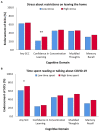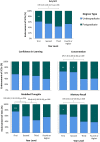Prevalence and correlates of subjective cognitive concerns in Australian university students during the COVID-19 pandemic
- PMID: 36710843
- PMCID: PMC9874933
- DOI: 10.3389/fpsyg.2022.1094497
Prevalence and correlates of subjective cognitive concerns in Australian university students during the COVID-19 pandemic
Abstract
Introduction: Coronavirus (COVID-19) instigated unprecedented global effects on healthcare systems, economies, employment, education, travel, and social lives. In addition to increased mental health challenges, pandemic restrictions have triggered emerging cognitive concerns. University students are at particularly high risk of adverse lockdown-related effects, yet despite the substantial adaptions to learning necessitated by COVID-19, limited research has so far focused on the cognitive consequences of the pandemic among university students. This study aimed to comprehensively examine the nature, prevalence, and correlates of subjective cognitive concerns among 972 students (Median age = 22 years, 70% female) enrolled at Monash University, Australia, in December 2020.
Methods: Students completed the online THRIVE@Monash survey, 5 weeks following prolonged lockdown in Melbourne. Using group comparisons and hierarchical binary logistic regression analyses, we examined associations between demographic and enrolment characteristics, COVID-19-related experiences and impacts (author-developed questions), self-reported anxiety and depression symptoms (PROMIS Anxiety and Depression scales), and students' perceived changes in everyday cognitive functions (author-developed questions).
Results: Over 60% of students reported subjective cognitive concerns (SCCs). After controlling for anxiety and depression symptoms, students reporting more SCCs were more likely to be younger, from White/European ethnic backgrounds, and in their first year of undergraduate study. No differences in SCCs were found between male and female students. Greater worry, anxiety, or stress related to COVID-19 (e.g., infection, leaving the house, hygiene and exposure prevention, impact on physical and mental health), and time spent reading or talking about COVID-19, were generally not associated with SCCs after controlling for anxiety and depression symptoms.
Discussion: These findings highlight vulnerable subgroups of students who might benefit from regular monitoring, education, and interventions to support their cognitive health during the pandemic and beyond. In addition, cognitive concerns may provide additional insight into mental health problems among students, and emphasize the importance of understanding factors that impact students' long-term academic and career success.
Keywords: COVID-19; cognition; pandemic; subjective cognitive concerns; university students.
Copyright © 2023 Bird, McCabe, Lim and Cornish.
Conflict of interest statement
The authors declare that the research was conducted in the absence of any commercial or financial relationships that could be construed as a potential conflict of interest.
Figures





References
-
- Australian Government . (2022). 2020 Student Summary Tables [Dataset]. Department of Education, Skills and Employment. Available at: https://www.education.gov.au/higher-education-statistics/resources/2020-... (Accessed October 20, 2022).
-
- Brown R. L., Moloney M. E., Brown J. (2018). Gender differences in the processes linking public stigma and self-disclosure among college students with mental illness. J. Community Psychol. 46, 202–212. doi: 10.1002/jcop.21933 - DOI
LinkOut - more resources
Full Text Sources

